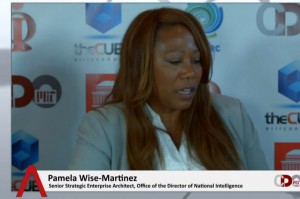 NEWS
NEWS
 NEWS
NEWS
 NEWS
NEWS
![]() A strong focus on interoperability, data standardization and sharing, disciplines around IT architecture and frameworks pave the way to a portfolio of common good for government organizations. Pamela Wise-Martinez, Senior Strategic Enterprise Architect, Office of the Director of National Intelligence, said her organization’s main concern is determining, at the highest level, what frameworks work best.
A strong focus on interoperability, data standardization and sharing, disciplines around IT architecture and frameworks pave the way to a portfolio of common good for government organizations. Pamela Wise-Martinez, Senior Strategic Enterprise Architect, Office of the Director of National Intelligence, said her organization’s main concern is determining, at the highest level, what frameworks work best.
In a live interview with theCUBE co-hosts Jeff Kelly and Dave Vellante at the MIT CDOIQ conference, Wise-Martinez said, “I do consider myself an enterprise architect.”
In her opinion, the role of the enterprise architect can fall under the Chief Data Officer (CDO), as the CIO is more focused on operations. Asked what drives this transition of the enterprise architect to be part of the CDO, she stated “it is a natural evolution.” The enterprise architect focuses both on technology and on business.
The CDO will really have a strategic focus on where that data is going, from an enterprise perspective, Wise-Martinez detailed. The enterprise architect lays out the capabilities and functions to help the CDO explain to the CIO, or in her case the Secretaries of State, where their data is going and how it is used.
“I think it is a more strategic role, and more importantly it is a role that’s really needed,” Wise-Martinez noted. “Who is really helping to charter, to manage, and help [the CEO’s] vision become reality more than the CDO?” In the Big Data discussion, the CDO helps take analytics and turns that insight into business capital.
In her own role, Wise-Martinez focuses on how to use data to enable U.S. citizens. “Being more citizen-centric, and even borrowing from our European counterparts” is one of the ideals to achieve, she explained. As an example, she mentioned life events — agencies develop the data around them, but use each event multiple times. “As a consumer, or a citizen, I am born, I pay taxes, I use healthcare. If I have data that can be used across those organizations,” it saves money, effort, and time when using data more effectively, Wise-Martinez said.
–
–
Commenting on this principle of reusing data as with the case of citizens’ life events, Kelly pointed out that the very real need to share data is a big challenge. Other than the technical component, there is always political component to sharing data.
“There’s privacy, there’s trust, there are really those components that say we need to be smart about how we share data,” Wise-Martinez explained. “We want to be broad and smart about that data. Privacy is at the top of the list, in terms of how and when and why you share the data.”
As a Program Manager of the Information Sharing Environment (PM-ISE), Wise-Martinez has a focus on information sharing, and more specifically on justice information sharing, with a goal to share data in ways that can promote the health and wealth of the country.
Asked if data owners were reluctant to share data, Wise-Martinez said, “I don’t believe it’s reluctance, it’s caution.”
–
–
Commenting on the technological changes in the last decade and their effect on data sharing, Wise-Martinez stated that “a lot of things have changed, but the principles in the discipline have stayed pretty much the same. What’s really changed is the increased necessity of really using that data smartly and using the technology to push and help this evolution of really sharing information.”
The system used to achieve the goals is to pay attention to the organizations that are doing things really really well. “We focus on them, we want to learn from those organizations, and share what we learn with organizations that are less mature,” Wise-Martinez said, “isolate the best practices, turn them into lessons learn, and share those lessons with the rest of the country. If you can reduce the IT burden, you can help organizations become more efficient and help them reduce cost,” Wise-Martinez said.
Asked how her work was evaluated, Wise-Martinez said she considers it effective if she is “building communities of sharing. We want to save lives, save money, and reduce the cost.” As far as results go, “the early returns say there’s a big and huge need and also that there’s value in what we’re doing. There’s value in having a Stay Local office or a fusion center, adopt common language in terms and patterns, because it saves us time and money at the end of the day,” she concluded.
THANK YOU